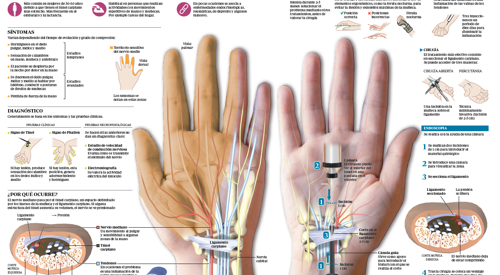Carpal tunnel surgery
"Virtually all patients experience satisfactory improvement with surgical treatment, and relapses are unlikely".

Carpal tunnel is a channel or corridor in the anterior or flexor face of the wrist. When the location of the nerve is reduced from any cause, the pressure inside increases and the nerve is compressed.
Carpal tunnel surgery can be either open, which is the conventional technique, or endoscopic, according to the experience of the professionals at the hospital.
It is an intervention that usually has no complications. After the surgery the pain disappears in days, and the rest of the symptoms improve in short term, depending on the gravity of the injury.

When is carpal tunnel surgery indicated?
Mild cases can evolve favorably with treatment by immobilization of the wrist or injection of steroids. In more advanced cases, the solution is always surgical, releasing the nerve trapped in the carpal tunnel.
Surgery to release the nerve is indicated in the following cases: if the symptoms persist despite medical treatment, if the neurophysiological study is very pathological, if there is an established sensory or motor deficit or if there are severe or progressive symptoms with an evolution of more than 12 months.
Practically all patients experience a very satisfactory improvement with surgical treatment.

Learn what carpal tunnel is and how it is treated (only in spanish)
Most frequent indications for this treatment:
Do you have carpal tunnel syndrome?
Surgical treatment may be indicated
How is carpal tunnel surgery performed?
Procedimiento de la operación del túnel carpiano
This intervention can be either open, which is the conventional technique, or endoscopic, depending on the experience of the professionals at the hospital. It can be done on an outpatient basis or with a stay of several hours, since the operation is short and is performed under local or regional anesthesia.
The procedure consists of making a small incision in the wrist and dividing the tissues until the median nerve is identified. After practicing a cross-section of the carpal ring ligament, the transit space of the nerve along the carpal tunnel is enlarged.
Recuperación postoperatoria
In the postoperative period, a bandage is placed on the wrist and the hand must be kept high with the help of a sling to prevent it from bleeding and becoming inflamed. It is important to move the fingers continuously and not to bend the wrist.
This intervention usually does not present/display complications.
The pain after the surgery disappears in a few days and the rest of the symptoms improve in a short term, depending on the gravity of the injury.
Practically all patients experience improvement and it is unlikely that the condition will recur.
Where do we do it?
IN NAVARRA AND MADRID
The Department of Orthopedic Surgery and Traumatology
of the Clínica Universidad de Navarra
The Department of Orthopedic Surgery and Traumatology covers the full spectrum of congenital or acquired conditions of the musculoskeletal system including trauma and its aftermath.
Since 1986, the Clinica Universidad de Navarra has had an excellent bank of osteotendinous tissue for bone grafting and offers the best therapeutic alternatives.
Organized in care units
- Hip and knee.
- Spine.
- Upper extremity.
- Pediatric orthopedics.
- Ankle and foot.
- Musculoskeletal tumors.

Why at the Clinica?
- Experts in arthroscopic surgery.
- Highly qualified professionals who perform pioneering techniques to solve traumatological injuries.
- One of the centers with the most experience in bone tumors.



















